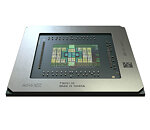Thursday, October 22nd 2020

AMD Seemingly Working on Cryptocurrency-focused Navi 10 GPU
New Linux patches seem to point towards a cryptocurrency-focused graphics card from AMD. First spotted by Phoronix, the patches add descriptions for a "navi10 blockchain SKU" - it's a pretty self-describing, well, description. The device ID is reported as 0x731E, and Phoronix says that the major difference between this graphics card and the other Navi 10 offerings in the market (namely RX 5700XT and RX 5700) is the absence of Display Core Next (DCN) and Video Core Next (VCN) engines. Whether these are absent from the silicon, or simply disabled by other means is currently unclear. Their absence, however points towards cards with no graphical outputs, a lapalissian practicality for cryptocurrency-focused graphics mining products.
Phoronix estimates a release of no sooner than early 2021, considering the timing of the patch information on Linux. While the market for GPU-accelerated cryptocurrency mining isn't what it used to be (luckily), there is still a market opportunity to be taken advantage of here - while ASICs have become more commonplace, there are still many GPU-mining alternatives within the realm of crypto. A crypto-focused product might steer users away from gaming-oriented consumer products, thus easing strain on supply for AMD's upcoming RX 6000 series - especially if this Navi 10-based GPU (or should we call it a CHU - Cryptocurrency Hashing Unit?) features some voltage and power adjustments to increase power efficiency on these workloads.
Source:
Phoronix
Phoronix estimates a release of no sooner than early 2021, considering the timing of the patch information on Linux. While the market for GPU-accelerated cryptocurrency mining isn't what it used to be (luckily), there is still a market opportunity to be taken advantage of here - while ASICs have become more commonplace, there are still many GPU-mining alternatives within the realm of crypto. A crypto-focused product might steer users away from gaming-oriented consumer products, thus easing strain on supply for AMD's upcoming RX 6000 series - especially if this Navi 10-based GPU (or should we call it a CHU - Cryptocurrency Hashing Unit?) features some voltage and power adjustments to increase power efficiency on these workloads.


41 Comments on AMD Seemingly Working on Cryptocurrency-focused Navi 10 GPU
All also depends on how RX 6000 series perform in mining since they are suppose to be 50% more power efficient.
Less power, cheaper Crypto, faster ROI.
1) divisive marketing mockering the rival (Nvidia having DLSS and ray tracing as a flexing tools);
2) "my friend has Nvidia, I don't know what the difference is between AMD and Nvidia so I don't care. I just want a desktop computer to play video games" or "my friend told me this so called AMD brand is bad so I'll carefully listen to his advice";
3) risk of facing off with unstable drivers, despite most of them being patched, they still pop up at random times;
4) lack of options on a certain price range and inconsistent pricing. In my area 5600XT costs +$10 over entry 2060. 2 AMD SKUs (5500XT, 5600XT) vs 5 Nvidia SKUs (1650,1650S,1660,1660S,1660Ti) in the low end (guess who wins the marketing vote), 1 AMD SKU (5600) vs 2 Nvidia SKUs (2060, 2060S) in the mid end, 1 AMD SKU (5700XT) vs 3(2080 kinda high end? 2070, 2070S) Nvidia SKUs in the high end, 0 AMD SKU vs 2 Nvidia SKUs (2080S, 2080Ti) in the top end.
Maybe AMD plans to sell out the remainder NAVI10 GPUs this way instead of putting and keeping them in the retail channel?
Would be interesting if RTG does actually have good quantities of RDNA2 offerings.
"The device ID is reported as 0x731E, and Phoronix says that the major difference between this graphics card and the other Navi 10 offerings in the market (namely RX 5700XT and RX 5700) is the absence of Display Core Next (DCN) and Video Core Next (VCN) engines. "
what are we gonna do with the containers of old junk that no gamer is gonna buy as soon as we release RDNA2?
throw this useless piece of silicon at the cryptoworld.
but serious:
does RDNA2 loose the fight against RDNA1 on this specific function? interesting...
What does (GPU) mining traditionally use: memory bandwidth: in other words saying the turbo-hyper-infinity-cache thing could perform worse in combination with lower memory bandwidth?
and actually now that i think of it, it could make sense:
for textures/shaders/pixels processing there is a clear order of operations that can occur, and when you know this loaded texture is no longer needed in the cache, thus invalidated/cleared.
for mining the order is not the same, so it is not clear when the data in the cache can be invalidated (or must always be invalidated)
hence requiring to fetch from memory, and hence requiring more memorybandwith.
Also gpu without displays need to have a better warranty than 3 months, gpus with displays have 3 years, so why people will buy specific gpus for blockchain that are not cheaper than gpus with display and offers 10 times less warranty time. No Deal.